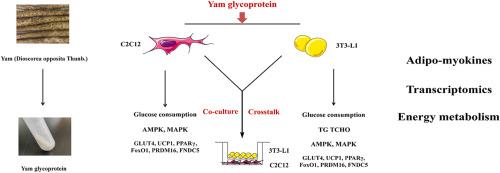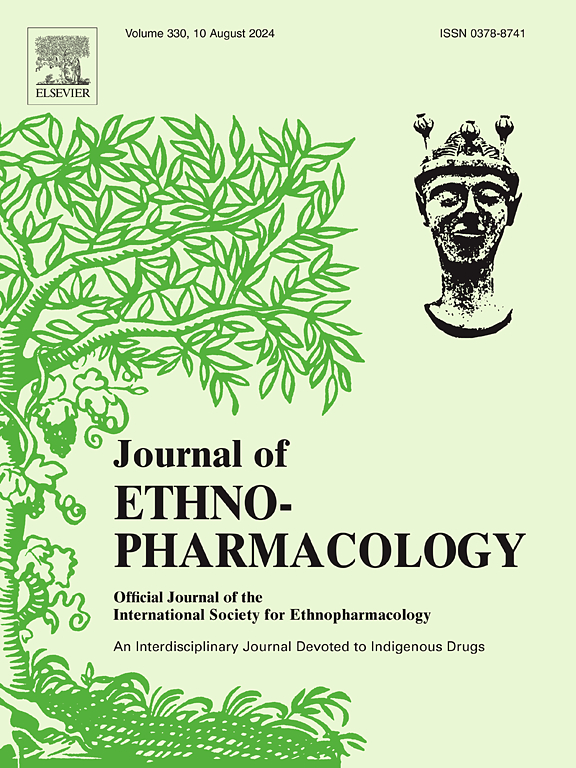山药(Dioscorea opposita Thunb.)糖蛋白对 C2C12 细胞和 3T3-L1 细胞能量代谢的调节作用以及这两种细胞之间的串联。
IF 4.8
2区 医学
Q1 CHEMISTRY, MEDICINAL
引用次数: 0
摘要
民族药理学意义:控制能量和调节新陈代谢一直是治疗肥胖等代谢性疾病的关键策略。山药糖蛋白(Yam glycoprotein,Y-Gly)是从山药中提取的一种多糖蛋白质复合物,对葡萄糖和脂质代谢有益。本研究旨在探讨Y-Gly在调节C2C12和3T3-L1细胞能量代谢中的作用:对 Y-Gly 进行提取和化学分析。主要使用染色方法、检测试剂盒、Western Blot 和转录组学来确定 Y-Gly 的作用。此外,该研究还采用细胞共培养技术,试图研究 Y-Gly 对 3T3-L1 细胞中白色脂肪褐变的影响:结果:Y-Gly 促进了 C2C12 肌母细胞的肌管分化,增加了细胞的葡萄糖消耗,促进了 ATP 合成和线粒体的生物生成,并在能量消耗和糖脂代谢相关途径(如 AMPK 和 MAPK)中发挥了积极作用。引入Y-Gly可抑制3T3-L1细胞脂肪生成后的脂质积累,促进诱导白脂肪褐变相关蛋白如PPARγ和UCP1的表达,且细胞共培养后效果更显著:结论:Y-Gly 通过激活上述途径中的关键蛋白来调节葡萄糖和脂质代谢,并通过肌肉和脂肪组织之间的串联在能量代谢调节中发挥作用。这表明 Y-Gly 可能在代谢相关疾病中发挥作用。本文章由计算机程序翻译,如有差异,请以英文原文为准。

Regulatory effects of yam (Dioscorea opposita Thunb.) glycoprotein on energy metabolism in C2C12 and 3T3-L1 cells and on crosstalk between these two cells
Ethnopharmacological relevance
Controlling energy and regulating metabolism have been key strategies in the treatment of metabolic disorders such as obesity. Yam glycoprotein (Y-Gly) is a polysaccharide-protein complex extracted from Chinese yam that has beneficial effects on glucose and lipid metabolism. This study aimed to investigate the role of Y-Gly in regulating energy metabolism in C2C12 and 3T3-L1 cells.
Materials and methods
Y-Gly was subjected to extraction and chemo-profiling. Staining methods, assay kits, Western Blot and transcriptomics were mainly used to determine the role of Y-Gly. Additionally, the study sought to examine the impact of Y-Gly on white adipose browning in 3T3-L1 cells, employing a cell co-culture technique.
Results
Y-Gly promoted myotube differentiation in C2C12 myoblasts, increased cellular glucose consumption, promoted ATP synthesis and mitochondrial biogenesis, and played an active role in energy expenditure and glycolipid metabolism related pathways such as AMPK and MAPK. The introduction of Y-Gly inhibited lipid accumulation after lipogenesis in 3T3-L1 cells, facilitated induction of white adipose browning related proteins such as PPARγ and UCP1 expression, and the effect was more significant after cell co-culture.
Conclusions
Y-Gly regulates glucose and lipid metabolism by activating the key proteins in the aforementioned pathways, and plays a role in energy metabolism regulation through crosstalk between muscle and adipose tissues. This suggests a possible role of Y-Gly in metabolism-related diseases.
求助全文
通过发布文献求助,成功后即可免费获取论文全文。
去求助
来源期刊

Journal of ethnopharmacology
医学-全科医学与补充医学
CiteScore
10.30
自引率
5.60%
发文量
967
审稿时长
77 days
期刊介绍:
The Journal of Ethnopharmacology is dedicated to the exchange of information and understandings about people''s use of plants, fungi, animals, microorganisms and minerals and their biological and pharmacological effects based on the principles established through international conventions. Early people confronted with illness and disease, discovered a wealth of useful therapeutic agents in the plant and animal kingdoms. The empirical knowledge of these medicinal substances and their toxic potential was passed on by oral tradition and sometimes recorded in herbals and other texts on materia medica. Many valuable drugs of today (e.g., atropine, ephedrine, tubocurarine, digoxin, reserpine) came into use through the study of indigenous remedies. Chemists continue to use plant-derived drugs (e.g., morphine, taxol, physostigmine, quinidine, emetine) as prototypes in their attempts to develop more effective and less toxic medicinals.
 求助内容:
求助内容: 应助结果提醒方式:
应助结果提醒方式:


